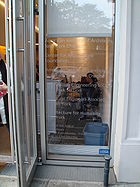
Center for Architecture
Encyclopedia



American Institute of Architects
The American Institute of Architects is a professional organization for architects in the United States. Headquartered in Washington, D.C., the AIA offers education, government advocacy, community redevelopment, and public outreach to support the architecture profession and improve its public image...
, the Center for Architecture is located in the neighborhood of Greenwich Village
Greenwich Village
Greenwich Village, , , , .in New York often simply called "the Village", is a largely residential neighborhood on the west side of Lower Manhattan in New York City. A large majority of the district is home to upper middle class families...
at 536 LaGuardia Place, between West 3rd Street and Bleecker Street in New York City
New York City
New York is the most populous city in the United States and the center of the New York Metropolitan Area, one of the most populous metropolitan areas in the world. New York exerts a significant impact upon global commerce, finance, media, art, fashion, research, technology, education, and...
(USA). In recent years, the center has become an increasingly important cultural institution through its revolving exhibits on architecture
Architecture
Architecture is both the process and product of planning, designing and construction. Architectural works, in the material form of buildings, are often perceived as cultural and political symbols and as works of art...
, urban planning
Urban planning
Urban planning incorporates areas such as economics, design, ecology, sociology, geography, law, political science, and statistics to guide and ensure the orderly development of settlements and communities....
, urban design
Urban design
Urban design concerns the arrangement, appearance and functionality of towns and cities, and in particular the shaping and uses of urban public space. It has traditionally been regarded as a disciplinary subset of urban planning, landscape architecture, or architecture and in more recent times has...
, and environmental planning
Environmental planning
Environmental Planning is the process of facilitating decision making to carry out development with due consideration given to the natural environmental, social, political, economic and governance factors and provides a holistic frame work to achieve sustainable outcomes.-Elements of environmental...
. The center also offers an extensive calendar of seminars, public feedback forums, project unveilings, and educational programs. The Center also keeps an online monthly calendar of events and changing exhibitions.
The Center for Architecture opened to the public in October, 2003.
Partner organizations housed at the Center for Architecture
- The American Institute of Architects New York Chapter
- The Center for Architecture Foundation
- American Society of Landscape ArchitectsAmerican Society of Landscape ArchitectsThe American Society of Landscape Architects is the national professional association representing landscape architects, with more than 17,000 members in 48 chapters, representing all 50 states, U.S. territories, and 42 countries around the world, plus 68 student chapters...
New York Chapter - Structural Engineers AssociationNational Council of Structural Engineers AssociationsThe National Council of Structural Engineers Associations is a professional society in the United States, with subchapters in 45 states and the District of Columbia. NCSEA was established in 1993, in Chicago...
of New York
The geothermal system at the Center for Architecture
In the summer of 2003 the geothermal system for the Center for Architecture was installed. For three weeks, construction crews drilled two wells, each 1,260 feet (~ 384m) deep beneath the sidewalk. After drilling through layers or gravel, pea stone, overburden soil and bedrock, the wells were connected to make a closed loop system. The geothermal system consists of 6 inches (152.4 mm) pipes, heat exchangers and pumps for groundwater to flow through.The geothermal system cools the Center for Architecture during warm weather and heats it during the cold months by circulating water through heat exchanger
Heat exchanger
A heat exchanger is a piece of equipment built for efficient heat transfer from one medium to another. The media may be separated by a solid wall, so that they never mix, or they may be in direct contact...
s. The system is based on the fact that the earth’s temperature at a thousand feet below Manhattan is a constant 52 °F (11.1 °C). The heat exchangers use the temperature of the water to cool (or heat as demand requires) the air released into the 12000 square feet (1,114.8 m²) facility through air ducts. Air is blown over the chilled or heated water before traveling into the galleries and office spaces.
Two other notable examples of geothermal installations in New York City are the Cook + Fox Front Street retail and residential development in southern Manhattan and the Full Spectrum affordable housing project, 1400 on Fifth Ave in Harlem. Both buildings use similar geothermal systems and other environmentally friendly elements such as recycled materials, green roofs and photovoltaics to reduce energy consumption.
In addition to being a forerunner of geothermal installations in Manhattan, it is the first publicly accessible system in New York City. The system regulates the air temperature in the building by circulating groundwater in a closed loop system of pipes and heat exchangers.
See also
- List of museums and cultural institutions in New York City
- eOCULUS - e-zine that highlights many events and lectures at the Center for Architecture.
- Philadelphia Center for ArchitecturePhiladelphia Center for ArchitectureFounded in 2002 by the Philadelphia, Pennsylvania chapter of the American Institute of Architects , the Center for Architecture performs the charitable and educational work of AIA Philadelphia. The Center's physical location opened in 2008 and serves as the chapter's home as well as a venue for...

